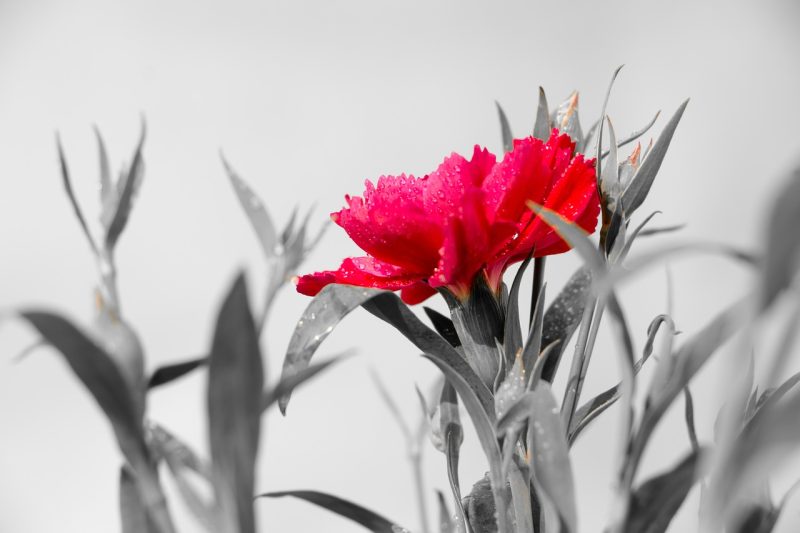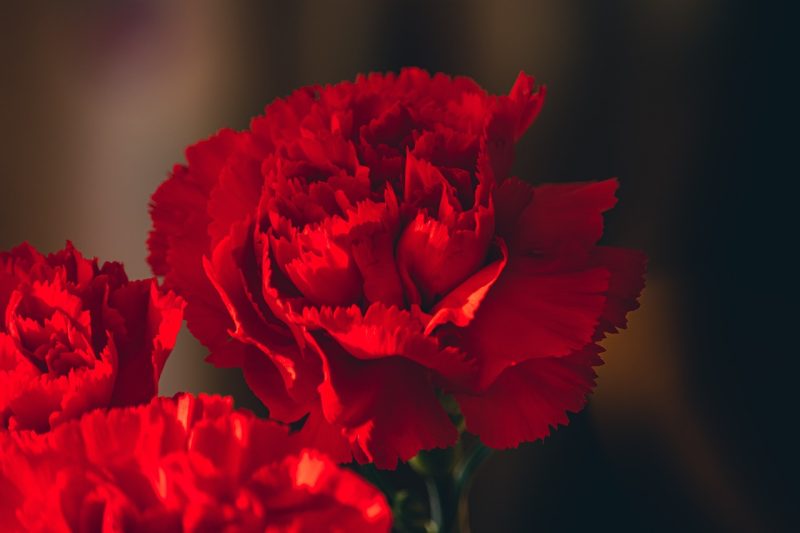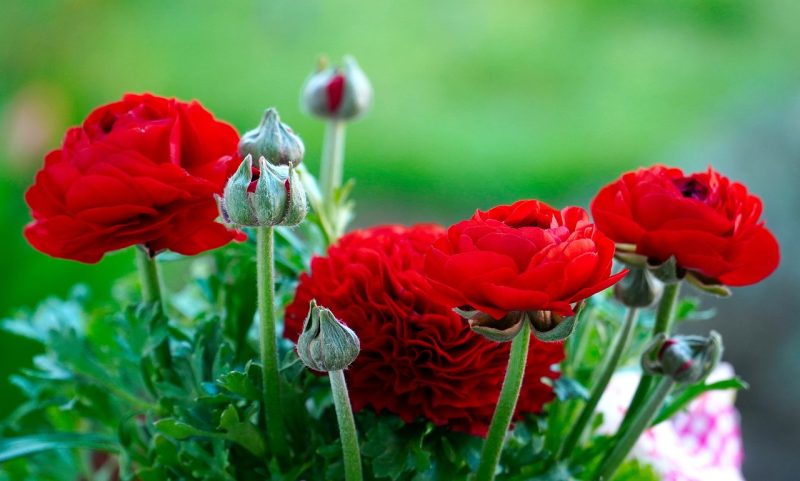As winter settles in and the landscape becomes a canvas of muted greys and whites, the striking presence of red winter flowers can bring warmth and vibrancy to the season. Not only do these blooms defy the cold, but they also offer a splash of color that can brighten even the dreariest days.
Camellia
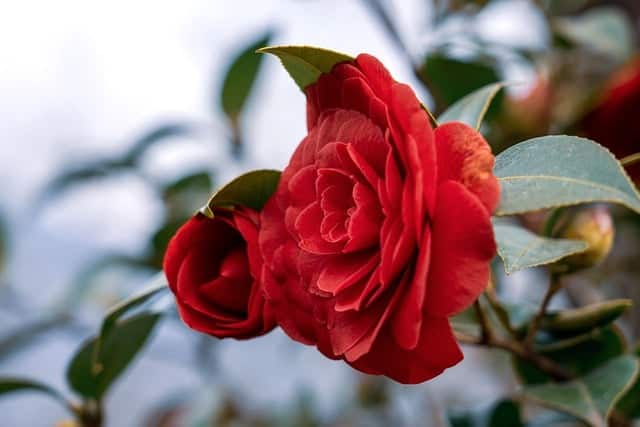
The Camellia, particularly the Camellia japonica, is a standout floral beauty that blooms when the temperatures drop, providing a much-needed contrast to the stark, wintry environment. These flowers can appear in various shades, but the rich, deep red varieties are particularly captivating.
What’s fascinating about Camellias is their cultural significance. In Japan, these flowers symbolize love and admiration, and they have been celebrated in art and poetry for centuries. Camellias are characterized by their glossy, evergreen leaves, which maintain their luster even under a layer of frost. In starting to bloom in late winter, they offer not just visual delight but also serve as a vital food source for early pollinators.
Proper care involves positioning them in partial shade with well-draining, acidic soil. They thrive in locations protected from harsh winds, which can damage their delicate blooms. Remember, Mulching around the base can protect the roots while helping retain moisture during dry periods. For gardeners looking to add a stunning focal point to their winter garden, the resilient Camellia proves an excellent choice, ushering in the spring season with style right when winter may feel at its longest.
WinterBerry

WinterBerry (Ilex verticillata) is a deciduous holly known for its vibrant red berries that cling to the branches long after the leaves have fallen. This striking characteristic makes WinterBerry a popular choice for winter gardens, as its bright berries offer a festive splash of color against the snowy landscape.
WinterBerry is not just visually appealing; it also takes on a crucial ecological role. The berries serve as an essential food source for various birds and small mammals during the winter months when food is scarce. The plant is dioecious, meaning it has separate male and female plants. Only the female plants produce berries, and for them to flourish, a male Ilex verticillata must be planted nearby for pollination.
Moreover, this plant thrives in wet, boggy soils, making it an ideal choice for low-lying areas or near ponds. By incorporating WinterBerry into your landscape, you not only enhance the winter scenery but also support local wildlife, creating a balanced ecosystem in your garden.
Dianthus
Dianthus, often referred to as “pinks” due to the fringed edges of its blooms, presents a charming option for those seeking red flowers during the winter months. Although they are commonly associated with summer gardens, particular varieties of Dianthus, such as Dianthus deltoides, have cold-hardiness that allows them to bloom intermittently even in winter.
Their cheerful red flowers, which often carry a sweet, clove-like fragrance, can be a delightful surprise against the stark winter backdrop. For many, the Dianthus also symbolizes fascination and love, often used in bouquets and arrangements to convey heartfelt sentiments.
While Dianthus typically prefers well-drained soil and sunny locations, gardeners should take care to protect them during unusually harsh winters. Incorporating mulch can help insulate their roots, and planting them in raised beds can provide additional drainage. As they bloom throughout the winter sporadically, their alluring fragrance can infuse the crisp, cold air with delightful scents, making each encounter with this resilient flower a memorable one.
Pansy
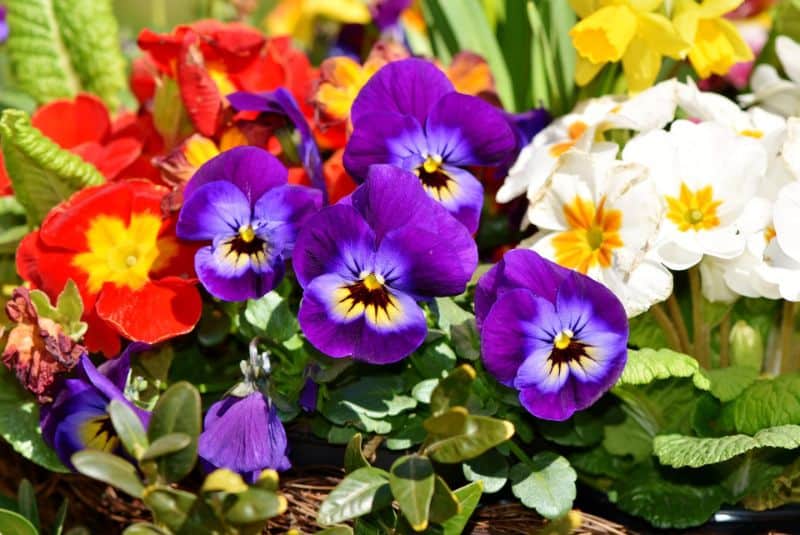
Pansies (Viola tricolor var. hortensis) are perhaps some of the most delightful red winter flowers, known for their vibrant colors and cheerful faces. While commonly associated with spring and fall, these hardy flowers can bloom from late winter into early spring, adding a burst of color when most plants are still dormant. Their ability to withstand frost and cold temperatures makes them a favored choice for those looking to beautify their gardens during the colder months.
Pansies are not just visually appealing; they also feature a unique, heart-shaped leaf that serves as a foundational element in many garden designs. The red varieties, often mixed with shades of purple and yellow, create stunning contrasts that are particularly striking against a blanket of winter snow. Additionally, their edible flowers can also be used in salads, desserts, and beverages, making them a functional as well as ornamental addition to any winter garden.
To ensure a thriving display of Pansies, it’s essential to plant them in well-drained soil and provide plenty of sunlight while protecting them from harsh winds. Regular deadheading encourages continuous blooming and allows their colorful faces to shine, ensuring your garden remains vibrant throughout the winter months.
Carnations
Carnations (Dianthus caryophyllus) bring a unique elegance to winter gardens with their richly hued blooms and clove-like scent. Though typically appreciated for their longevity as cut flowers, certain varieties of carnations can also flourish in colder conditions. The red carnations, recognized for their deep color and intricate petal formations, add depth and character to any winter floral display.
In addition to their aesthetic appeal, carnations carry significant meanings in various cultures, often symbolizing love and fascination. This cultural resonance has made them popular choices for winter holidays and festivities, where their vibrant colors can enhance the seasonal decor. Interestingly, they are known for their ability to produce a wider range of colors, with red being particularly striking.
Gardeners can maximize the blooming potential of carnations by ensuring they are planted in fertile, well-draining soil and given adequate sunlight. While they can tolerate some frost, protecting them with a light mulch can help them thrive during particularly cold spells. With the proper care, these hardy flowers can last throughout the winter, providing delightful clumps of red that uplift any garden or landscape.
Petunia
Although Petunias (Petunia spp.) are often thought of as annual summer flowers, many varieties are surprisingly resilient and can thrive even in mild winter climates. The red variations, with their vibrant, trumpet-shaped blooms, are not just a favorite for gardeners; they are also known to attract pollinators, adding life to the winter garden environment. Their sweeping colors can transform empty beds into captivating floral displays, reminiscent of warmer days.
Petunias exhibit a range of colors and patterns, but the deep red hues stand out particularly against the winter landscape, making them a focal point in container arrangements or garden beds. Their trailing nature allows them to cascade beautifully over containers, creating stunning visual effects while adding texture to winter arrangements.
When planting Petunias in the winter, it’s crucial to select the right varieties—look for trailing or compact forms that can withstand the cold better than typical garden varieties. Providing them with well-draining soil, sufficient sunlight, and regular watering will help keep them thriving through the cooler months. By nurturing these vibrant flowers, gardeners can create a lush winter oasis that evokes joy and warmth despite the chill in the air.
Salvia
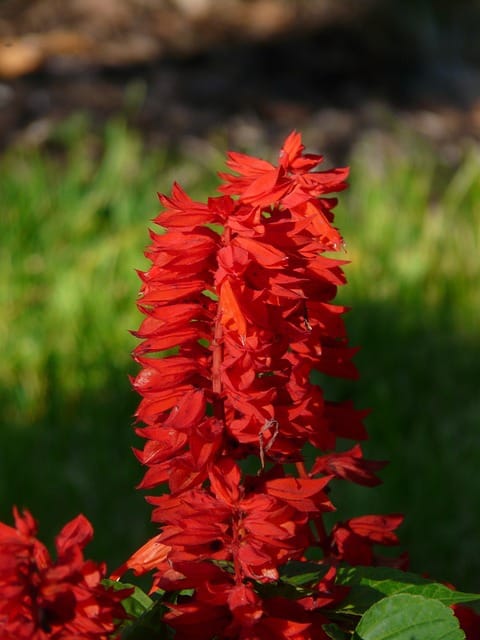
Salvia, particularly Salvia microphylla, also known as “Texas sage” or “little-leaf sage,” showcases stunning red flowers that add a bold touch to winter gardens. Typically favored for their resilience and ability to thrive in challenging conditions, these plants can endure frost and remain vibrant even in the cooler months. Their tubular flowers, which can appear throughout winter in milder climates, attract various pollinators, contributing to ecosystem activity during the quieter winter season.
What distinguishes Salvia is not only its striking blooms but also its beautiful grey-green foliage, which remains lush throughout winter, creating a foundation for visual interest even when the flowers are absent. These hardy plants prefer full sun and well-draining soil, making them relatively easy to care for. Continuous deadheading encourages protracted blooming and ensures that your garden remains a tapestry of red amidst the winter hues. Combining Salvia with other winter-friendly flora can create a dynamic, colorful landscape that defies seasonal expectations.
Poinsettia
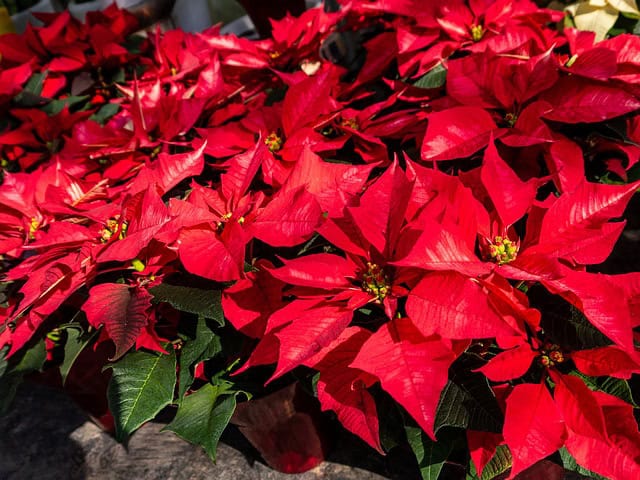
No discussion of red winter flowers can be complete without mentioning the Poinsettia (Euphorbia pulcherrima), a festive favorite during the holiday season. Known for its stunning bracts that come in vibrant shades of red, the Poinsettia has become synonymous with Christmas celebrations across the globe. These plants thrive indoors, but they can also be acclimatized to outdoor conditions in warmer climates, bringing their breathtaking beauty to winter gardens.
While often mistaken for flowers, the captivating red parts of the Poinsettia are actually modified leaves or bracts that surround its true flowers at the center. The cultural significance of Poinsettias is profound; they symbolize goodwill and elegance during the winter months. Their light fragrance and aesthetic appeal make them loved by many and a popular choice for holiday decorations.
To ensure Poinsettias flourish during the winter, they require bright, indirect light and proper watering without oversaturation, which can lead to root rot. They enjoy temperatures that stay above 60°F (16°C), making them perfect for indoor displays. When positioned thoughtfully, Poinsettias can infuse an indoor space or protected outdoor area with a festive and cheerful atmosphere, becoming a memorable focal point in any winter landscape.
Poppies
While often associated with spring, certain species of Poppies, especially the Icelandic Poppy (Papaver nudicaule), can delight gardeners with their vibrant red flowers even in winter, particularly in mild climates. These perennial blooms can withstand cooler temperatures and can be grown from seed in the autumn, providing the promise of vivid colors as winter fades. Their delicate yet striking appearance brings liveliness and interest to winter gardens.
Poppies are remarkable for their large, cup-shaped blooms that sway gracefully in the wind, creating a gentle movement among the foliage. While Poppy plants are primarily known for their traditional annual bloom cycle, the cold hardiness of varieties like the Icelandic Poppy allows for extended blooming seasons. This makes them an exciting choice for those looking to maintain color in their gardens during winter months.
To cultivate Poppies successfully, plant them in a location where they can bask in full sun with well-draining soil. These flowers thrive when nestled in slightly sandy or rocky soil, simulating their natural habitat. Their bright red petals not only captivate the eye but also provide a valuable food source for pollinators emerging as spring approaches. Thus, incorporating Poppies into your winter garden can create an enchanting landscape that transcends seasonal barriers.
Ranunculus
Ranunculus, specifically Ranunculus asiaticus, often known as Persian Buttercup, is celebrated for its captivating layered petals and vivid red hues. Though typically associated with springtime, with careful attention, these flowers can thrive in winter gardens, particularly in milder climates where conditions allow for a delightful display. Their rich, satin-like texture and bold color create a stunning contrast against the monochromatic backdrop of winter, making them a favorite among gardeners seeking to create interest during the colder months.
One of the remarkable traits of Ranunculus is their adaptability; they can be planted as corms in fall or early winter, providing a head-start for spring blooms. Even though they are sensitive to extreme frost, they can endure mild winter temperatures, especially when paired with protective mulch that insulates their roots. The plants prefer full to partial sunlight, requiring well-draining soil to prevent root rot.
Incorporating Ranunculus into your winter garden not only adds a splash of red but also attracts pollinators as they emerge in early spring, creating a vital link within the ecosystem. Their long-lasting blooms make them ideal for cut flower arrangements, too, ensuring that their beauty can be enjoyed both in the garden and indoors.
Tulips
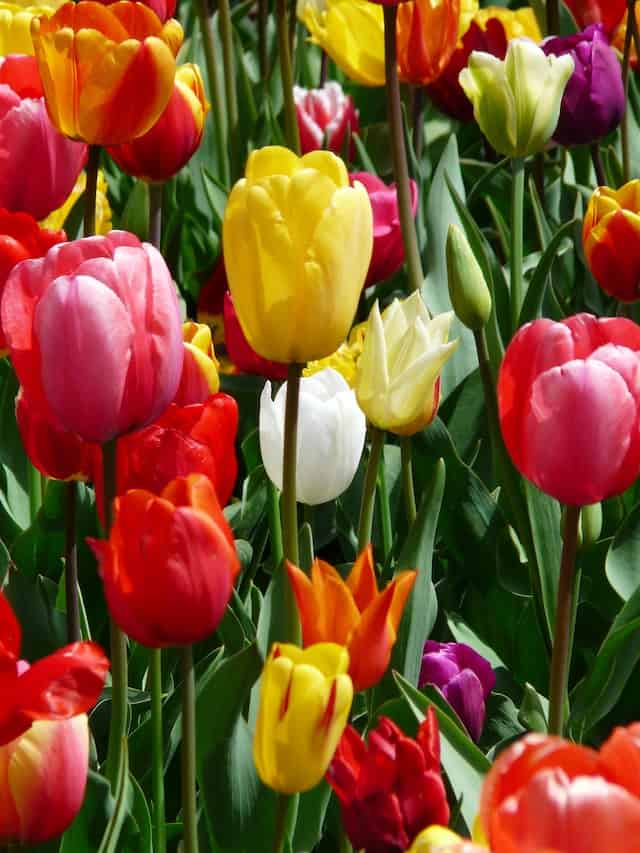
Tulips (Tulipa spp.) are iconic harbingers of spring, but certain early-blooming varieties can grace winter gardens with their brilliant red colors. Some species tulips, such as the Darwin Hybrid Tulips and Kaufmanniana Tulips, are known for their cold hardiness and ability to bloom shortly after the frost begins to thaw, offering a stunning outdoor spectacle as the garden slowly awakens from its winter slumber.
These flowers boast a classic shape and vivid hues, making them one of the most beloved types of landscape flowers. Red tulips symbolize passion and love, intriguing many who choose to plant them as a sign of beauty during the winter months. When planted in well-draining soil and placed in full sunlight, tulips thrive and flourish, showcasing their radiant blooms amidst the seasonal transition.
Planting tulip bulbs in the fall allows them to undergo the necessary chilling period, setting the stage for a powerful display once winter begins to wane. Adequate watering and protection from harsh winds are essential for their growth during early spring, as these elements can damage delicate buds.
Moreover, tulips can create a breathtaking visual impact when complemented by other winter-blooming flowers, creating a harmonious blend of textures and colors. Utilizing the dynamic red hues of tulips can invigorate a winter garden, capturing the imaginations of all who pass by and offering a glimpse of the vibrant life that awaits just around the corner as winter draws to a close.



